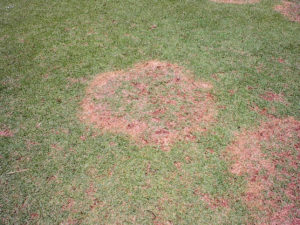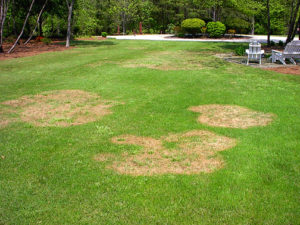 Winter Patch in warm season turf is caused by Rhizoctonia. This is the same fungus that causes Brown Patch in Fescue lawns. This problem usually appears between early March and mid May as the warm season turf begins to break dormancy and begins to green up for the year.
Winter Patch in warm season turf is caused by Rhizoctonia. This is the same fungus that causes Brown Patch in Fescue lawns. This problem usually appears between early March and mid May as the warm season turf begins to break dormancy and begins to green up for the year.
This is not necessarily a recurring problem but if it does develop each spring there may be factors in place in your lawn that are encouraging the disease development.
We see this problem not only in turf that is highly maintained, such as reel mowed turf, but also in normally mowed turf. Allowing your lawn to become dry in the fall prior to the first frost or allowing the thatch to build to an excessive level also encourages disease development.
Compaction can also stress the turf by reduce root growth and vigor. Compacted soil produces weak turf that is very susceptible to winter patch development.
Ask yourself these questions:
- Are you aerating each spring to reduce compaction? If not schedule a core aeration.
- Are you watering sufficiently during the fall prior to the onset of turf dormancy?
- Are you mowing at a high setting in September and October to allow the turf root systems to rebuild and allow the plant to store not only enough energy for overwintering but also for spring green up?
- If you have answered yes to all these questions then your growing environment coupled with previous weather patterns may simply be allowing the fungus to infect the turf.
Regardless you may require a fall application of fungicide to help reduce the development in the spring of the disease. These treatments can be expensive.
« Back to Glossary Index